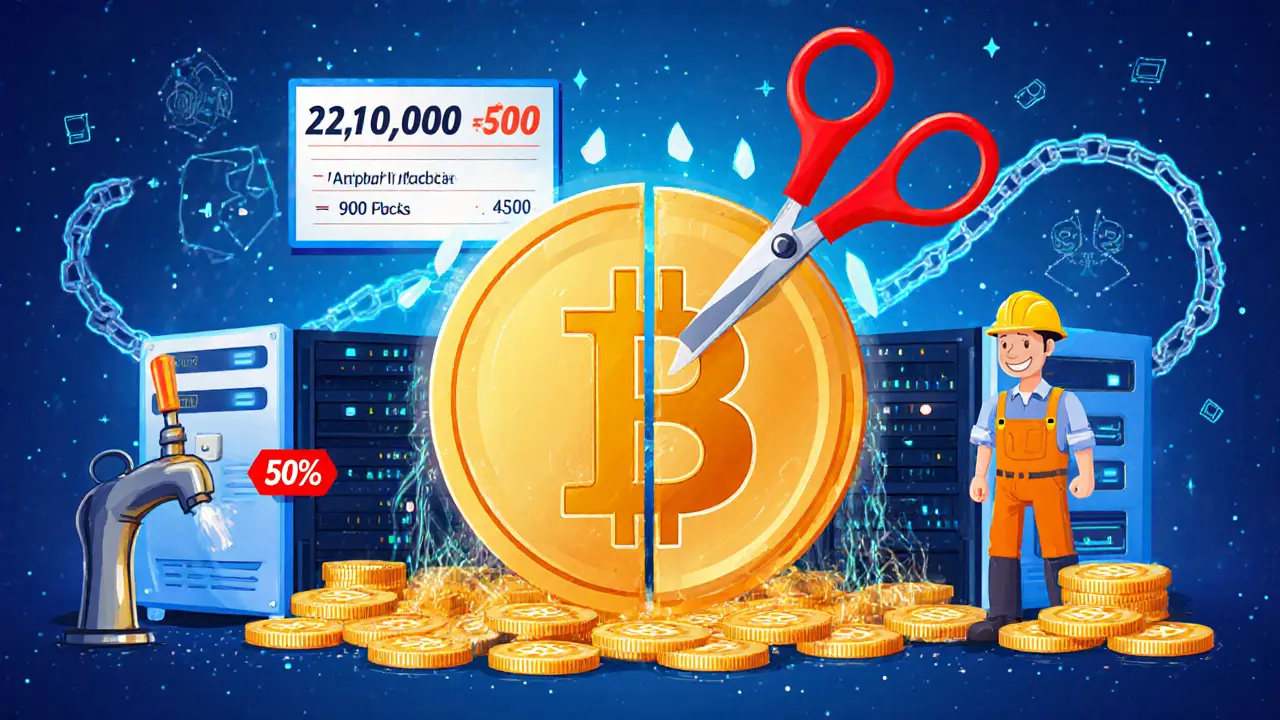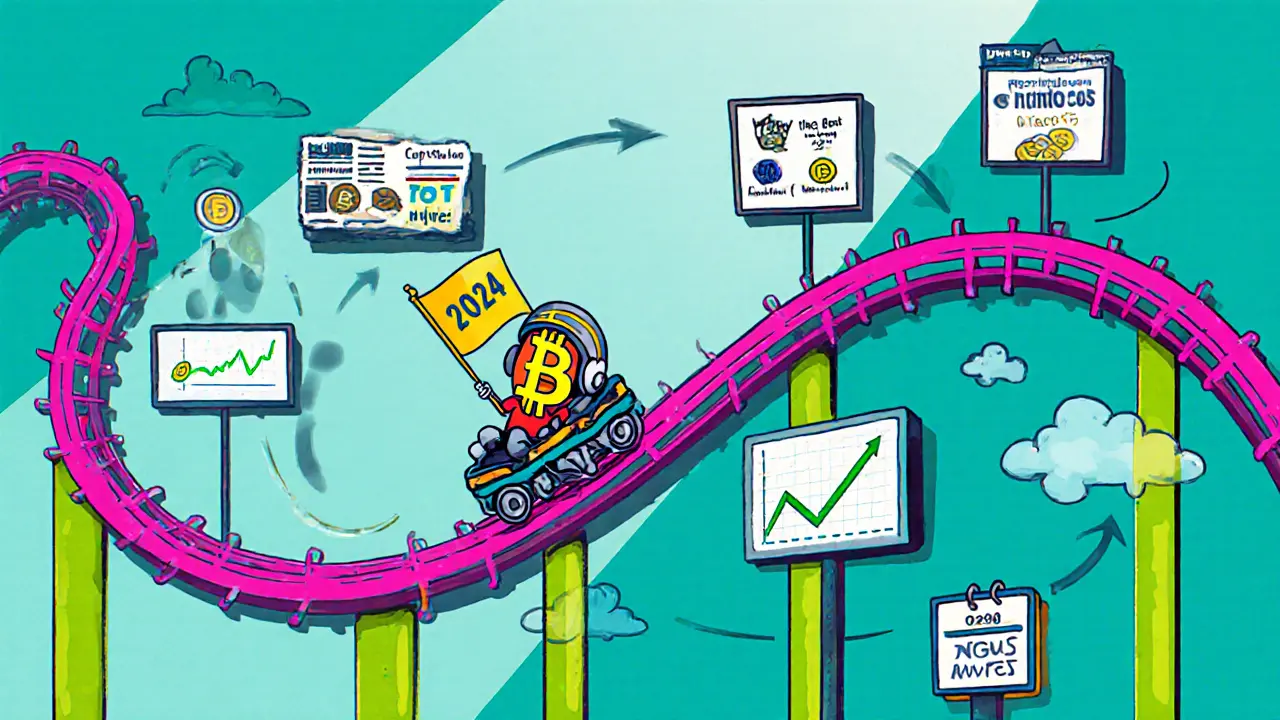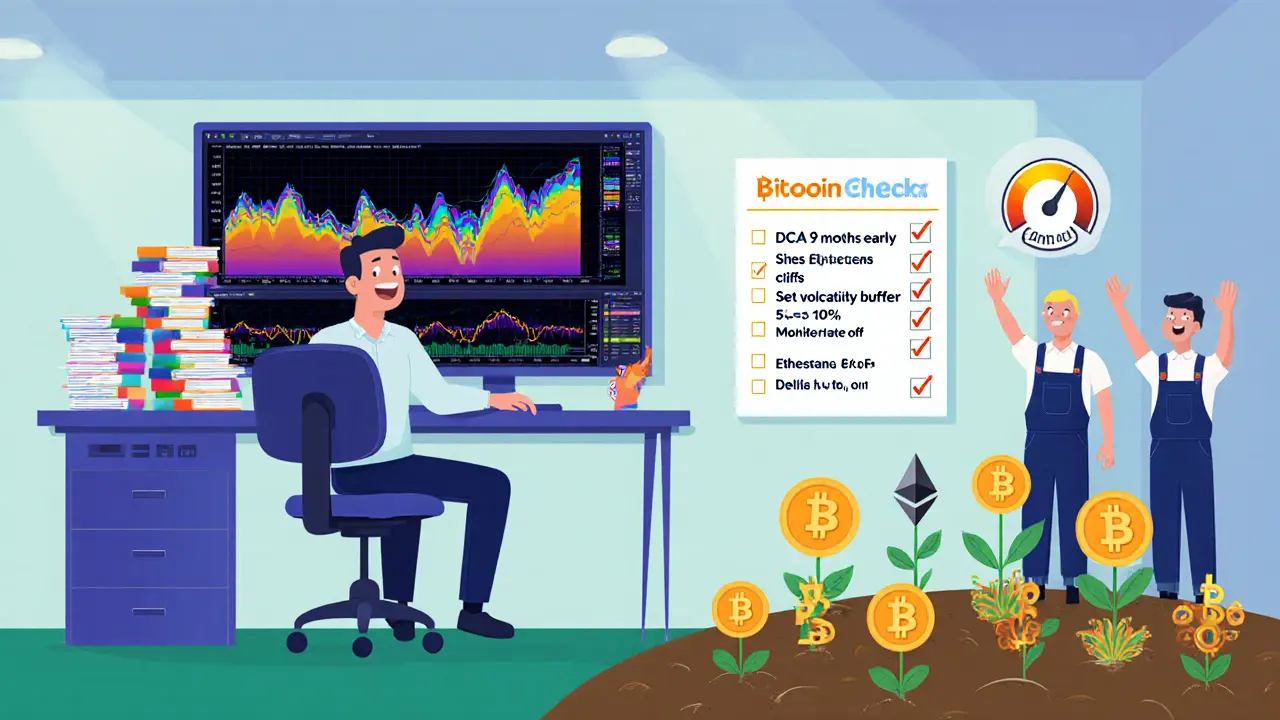
- 2 Jan 2025
- Elara Crowthorne
- 19
Bitcoin Halving Price Predictor
Predict Future Bitcoin Price After Next Halving
Based on historical patterns, estimate the potential price of Bitcoin following the next halving event in 2028.
Prediction Results
Important Note: This prediction is based on historical patterns and should not be considered financial advice. Cryptocurrency investments are highly volatile and risky.
Historical Halving Data
| Halving Event | Date | Block Reward | Price at Halving | Peak Price | Time to Peak (Months) |
|---|---|---|---|---|---|
| 1st | November 2012 | 25 BTC | $1,241 | $11,632 | 16 |
| 2nd | July 2016 | 12.5 BTC | $650 | $64,800 | 14 |
| 3rd | May 2020 | 6.25 BTC | $61,000 | $112,000 | 14 |
| 4th | May 2024 | 3.125 BTC | $68,000 | $112,000 | 14 |
When the Bitcoin Halving a programmed cut in new Bitcoin creation that occurs every 210,000 blocks (about four years) hits, the whole crypto world feels the tremor. In plain terms, the daily flow of fresh coins drops 50%, and traders scramble to guess what that means for prices, miners, and even the altcoins that ride Bitcoin’s coattails. This guide walks you through the anatomy of a halving, the historic price waves that followed, and concrete steps you can take whether you’re a casual holder or a seasoned swing trader.
Key Takeaways
- The halving cuts block rewards in half, slashing daily Bitcoin issuance from ~900 to ~450 coins after the 2024 event.
- Three past halvings show a repeatable pattern: price rally starts months before the event, peaks 12‑18 months after, then retreats.
- Mining profitability plunges, prompting exit of marginal miners and temporarily reshaping network security.
- Altcoins typically surge in the months surrounding a halving, driven by Bitcoin‑linked capital flows.
- Effective strategies combine early positioning, volatility buffers, and order‑flow tools like Bookmap.
What Exactly Is a Bitcoin Halving?
Every time the blockchain reaches 210,000 new blocks, the protocol automatically halves the reward miners receive for validating a block. The first reward was 50BTC, then 25BTC, 12.5BTC, and most recently 6.25BTC fell to 3.125BTC on the May2024 halving. This isn’t a policy decision-it’s baked into the code, making Bitcoin a built‑in deflationary asset. The goal? Replicate the scarcity of gold while avoiding the endless money printing that fuels fiat inflation.
Historical Market Cycle Timeline
Only three halvings give us a data set, but the pattern is striking. Below is a snapshot of key milestones:
| Metric | Before May2024 | After May2024 |
|---|---|---|
| Block reward | 6.25BTC | 3.125BTC |
| Daily new BTC | ≈900BTC | ≈450BTC |
| Hashrate (petahash/s) | 320PH/s | ≈300PH/s (short‑term dip) |
| BTC price at halving | $61,000 (2020) | $68,000 (2024) |
| Peak price after halving | $64,800 (2021) | $112,000 (2025‑06) |
Notice the price at the 2024 halving was already higher than the 2020 level, and the subsequent peak surged by more than 60% within a year. The timeline typically looks like this:
- Pre‑halving hype - demand spikes as media coverage builds.
- Supply shock - daily issuance halves, creating a short‑term scarcity.
- Post‑halving rally - price climbs for 12‑18 months, often outpacing broader crypto indices.
- Correction phase - markets cool, miners adjust, and a new bottom forms.
- Cycle reset - the next halving looms, restarting the cycle.

Why the Halving Moves Prices - The Supply‑Demand Lens
Think of Bitcoin like a limited‑edition sneaker drop. If you keep releasing the same number of pairs every week, hype fades. Cut the weekly drop in half, and collectors rush to buy before they run out. The halving does exactly that for Bitcoin’s supply. Demand, however, doesn’t shrink - it often rises because investors see the built‑in scarcity as a hedge against fiat inflation.
Empirical work from Bitcoin Suisse a Swiss crypto research firm quantified the lag between halving dates and price peaks, finding an average of 14months. Their model also flagged a 6‑month window before the halving where volatility spikes, a sweet spot for traders who thrive on rapid price swings.
Trading Strategies Around a Halving
Every trader has a risk appetite, so let’s break down three practical approaches that map to the cycle phases.
- Pre‑halving accumulation - Start building a position 6‑9months ahead when sentiment begins to shift positive. Dollar‑cost averaging (DCA) helps smooth out short‑term spikes.
- Volatility breakout - Use a tighter stop‑loss and aim for 10‑30% moves during the two‑week window surrounding the exact halving date. Tools like Bookmap an order‑flow visualizer that shows liquidity pockets let you spot sudden order‑book imbalances.
- Post‑halving trend ride - Once the price breaks above the pre‑halving high, lock in a trailing stop and let the rally run through the 12‑month peak window.
Regardless of the style, always allocate a volatility buffer (typically 5‑10% of your position) because the market can swing wildly on news-think macro‑policy changes or major exchange listings.
Impact on Miners and Network Security
Halving cuts the reward, so marginal miners-those whose electricity costs are close to the revenue line-often shut down rigs. In the weeks after the 2024 halving, the global hashrate dipped by about 6%, a modest dip thanks to the rise of more efficient ASICs. However, a prolonged exodus could lower the network’s defense against 51% attacks.
Watch two metrics to gauge miner health:
- Hashrate trend - sustained declines signal reduced participation.
- Mining profitability index - calculated as BTC price ÷ (reward×energy cost per BTC). When this falls below 1, many miners become unprofitable.
If you notice a sharp hashrate drop, it might be time to tighten your stop‑loss, as the market could experience a correction driven by security concerns.

Ripple Effects on Altcoins
Bitcoin leads the crypto market, so its cyclical moves cascade to altcoins. Historically, the 12‑month post‑halving window has seen:
- Ethereum price increase of roughly 45%. \n
- DeFi token rebounds of 30‑70% depending on project fundamentals.
- Higher correlation (r>0.8) between Bitcoin and the broader Crypto10 index.
One practical rule: allocate 20‑30% of your halving‑era capital to a basket of high‑volume altcoins, rebalancing every quarter to capture the “spill‑over” rally.
Practical Checklist for the Next Halving (2028)
- Mark the calendar: the next halving is expected around May2028.
- Set up a DCA schedule: start buying 9months before the target date.
- Install an order‑flow tool (e.g., Bookmap) and configure alerts for liquidity cliffs.
- Monitor miner health: track hashrate and profitability index weekly.
- Prepare a volatility buffer: keep 5‑10% of your position in cash or stablecoins.
- Plan altcoin allocation: choose 3‑5 projects with strong fundamentals and set a 20% exposure limit.
- Review macro‑economic backdrop: watch inflation data and Fed policy, as they can amplify or dampen demand.
Following this list won’t guarantee profits, but it aligns your actions with the patterns that have repeated over the last three cycles.
Frequently Asked Questions
Why does the bitcoin halving matter for price?
The halving cuts the flow of new coins in half while demand often stays steady or grows. That supply‑demand squeeze creates upward pressure, which historically leads to price rallies.
Can a halving cause a security risk for Bitcoin?
If many miners exit because rewards shrink, the total hashrate can dip. A lower hashrate makes a 51% attack cheaper, but the effect is usually short‑lived as remaining miners adjust and newer, more efficient hardware comes online.
How should I trade Bitcoin right before a halving?
Many traders use a combination of DCA to build a base position and short‑term breakout trades during the two‑week window around the halving. Keep tight stops and consider using order‑flow charts to catch sudden liquidity shifts.
Do altcoins always rise after a Bitcoin halving?
Not every altcoin, but the overall market tends to get a boost because capital flows from Bitcoin into other assets. Strong projects can out‑perform, while weaker ones may still lag.
What tools help monitor halving‑related volatility?
Order‑flow visualizers like Bookmap, real‑time on‑chain analytics (e.g., Glassnode), and traditional volatility indicators (Bollinger Bands, ATR) give a rounded view of market stress.

19 Comments
Yo, the halving thing always gets hype but you gotta stay chill.
Honestly, people who chase these price predictions without a moral compass are just feeding the greed machine. The market already manipulates the vulnerable, and you add to that by glorifying speculation. If you truly care about the community, you should emphasize responsible investing, not just excitement. Everyone should remember that real wealth comes from building, not from riding hype waves.
While the prevailing narrative glorifies halving‑driven rallies, one must acknowledge that the data can be interpreted in myriad ways; the causal link is not as deterministic as many proclaim. Moreover, the over‑emphasis on price ignores the underlying network security concerns, which may manifest as transient hash‑rate drops. Consequently, a prudent investor should remain skeptical of any simplistic bullish forecast.
What they don’t tell you is that every halving is a perfect time for the elite to whisper about "new tech" while quietly off‑loading their positions. The mainstream media will hype the next surge, but the real moves happen behind the curtains where the conspiratorial forces align. Keep an eye on mining pools that suddenly change their strategy; that’s often the first sign of the hidden agenda.
Great rundown! The halving cycles really do shape market psychology, and having a clear checklist can keep emotions in check. Remember, patience and discipline beat hype every time. Let’s keep the optimism grounded in solid strategy!
Totally agree with the checklist, especially the part about keeping a volatility buffer. It’s easy to get swept up in the hype without that safety net.
The halving calendar is not just a date on a spreadsheet; it signals a fundamental shift in Bitcoin’s issuance rate that has historically preceded massive market re‑alignments; every four years the block reward is cut in half, which instantly reduces the influx of fresh coins; because demand tends to be relatively inelastic in the short term, that supply shock creates upward price pressure; the data from 2012, 2016, 2020 and 2024 shows a clear pattern of post‑halving rallies that peak roughly a year after the event; however, the magnitude of each rally has varied widely, driven by macro‑economic conditions, institutional participation, and miner behavior; for instance, the 2016 rally was amplified by the emergence of futures markets, while the 2020 run benefited from pandemic‑induced liquidity; looking ahead to 2028, we should expect tighter mining margins, which could force less efficient miners out of the network; that hashrate consolidation often precedes a short‑term dip in security, but the network typically rebounds as newer ASICs are deployed; investors can hedge this risk by keeping a modest cash buffer, say 5‑10% of their position, to ride any temporary volatility; a disciplined dollar‑cost‑averaging strategy that starts nine months before the halving can smooth out price noise; at the same time, allocating a portion of capital-perhaps 20‑30%-to high‑volume altcoins can capture the “spill‑over” effect that often follows a Bitcoin rally; remember to monitor on‑chain metrics like miner revenue and hash‑rate health to gauge when the market might be turning; tools like Glassnode and Bookmap give real‑time insight into liquidity cliffs that can trigger sharp moves; finally, never forget that past performance is not a guarantee of future returns, and staying disciplined is the key to surviving the next cycle.
From a technical standpoint, the upcoming halving will likely compress the supply curve, leading to tighter order‑book depth. Traders should consider tightening stop‑loss thresholds to account for increased volatility. Combining on‑chain analytics with traditional charting can improve entry timing.
Respectfully, that advice sounds like another hype‑pump. It’s better to stick with simple, low‑risk strategies.
Don’t be fooled by the mainstream narrative; every halving is a perfect storm for meme‑driven manipulation. The elite use the hype to reset market expectations, then quietly shift the underlying power structures. Look out for sudden changes in mining distribution; those are often the first clues of a deeper agenda. The more the community buys into the "price‑rise" story, the more vulnerable we become to systemic shocks. Stay vigilant, question everything, and never trust the hype blindly.
🙌 Totally see your point – staying aware is key! Let’s keep the community informed and safe. 🚀
From a cultural perspective, the halving has become a ritual that unites global participants. It’s fascinating how a technical protocol can generate such shared anticipation. Still, we should remember that beyond the hype lies real technology evolution. The community thrives when we balance excitement with grounded analysis.
The philosophical angle is that markets reflect collective belief, and halving cycles amplify that belief. If we detach from the emotional surge, we can make clearer decisions. Ultimately, rational thought should guide our actions.
Enthusiasm is great, but let’s not forget to set realistic profit targets! Discipline beats reckless optimism every time.
I appreciate the optimism, though I’d caution against over‑extending positions. Keeping a modest exposure can protect against sudden dips.
Absolutely! The market’s roller‑coaster can be thrilling, but never lose sight of the risks. Stay sharp, stay safe.
Everyone’s hyped about the next surge, but I think we’re due for a correction soon.
That’s just another liberal‑led narrative trying to destabilize our economic freedom. We must stand strong and protect our assets.
Let’s keep the discussion constructive and focus on sharing reliable strategies. Together we can navigate the next cycle responsibly.